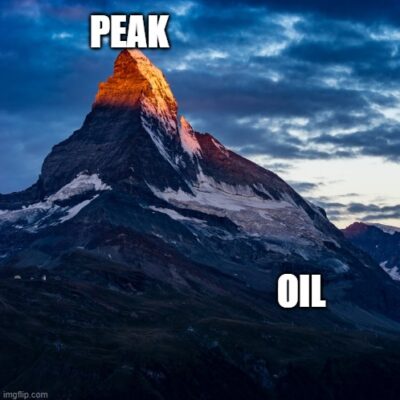For us oil and gas types, there is a thing that happens around this time every year. You can almost set your old timey pocket watch by it, it is that predictable. No, I’m not talking about football (although let’s face it, I could be), nor am I talking about the annual exodus of Canada Geese to warmer climes or the annual weather debacle that is the Atlantic Hurricane season.
No, I’m talking about that September rush to get predictions in for next year, particularly on the energy side where it seems not a September goes by that some think tank, corporate entity, investment house or ENGO comes out with a particularly dire forecast for the energy industry.
These forecasts, for better or worse, are invariably seized upon by various and sundry in the media and given outsized airplay in the service of whatever pet argument or cause of the month is in ascendance.
And so it was just over a week ago when the venerable BP (otherwise known as British Petroleum or the company formerly renowned for its ability to blow GoM wells like nobody’s business) came out with its annual compendium of all things predictive – their BP Statistical Review of World Energy. Look, I know it’s a pretty dry sounding name, but stick with me.
The work of scholarly magnificence is the compendium of all of BP’s accumulated energy knowledge from the pr3wevious year and a window into where this energy supermajor sees the world and itself evolving. And let’s just say, for a company with the word “petroleum” in its acronym and its roots in counter-revolutionary espionage riddled Iran, this report does not pay proper fealty to its origin story in the least.
Instead, sacrilege, the BP report dares to venture the view that global demand for oil is likely to begin decreasing much sooner than previously postulated. Perhaps as soon as, gasp, 2023? Really? That seems unduly harsh.
Immediately we could hear the cries of “see!, take that Alberta” “wind it down” “green new deal” “it’s Trudeau’s fault” and “call the war room”.
Look, all of this is fun and games and silliness, and BP is just one player among many to have a view on “Peak Oil Demand”, but before we decide to throw the entire industry over the rails, it might be a good time to take a step back, have a big gulp of Alberta Premium Cask Strength Rye (top whiskey in the world – completely sold out in the heartland) and get some perspective.
First, BP has been chasing the green brass ring for years. Remember their solar foray? It has been more than a decade’s worth of trying to polish their image after the disastrous and costly Macondo blow out that saddled them with many billions of additional liability, not to mention the derision of an entire continent, or maybe even world.
This chase has taken many forms, from announcing plans to be carbon neutral by 2050 to pursuing alternative energy projects to currying favour with the ESG crowd by creating some pretty graphs about what happens to oil and gas consumption if the implausible becomes plausible.
Don’t get me wrong. I know oil and gas demand growth will peak and decline sometime in the future. I’m not a dummy. But I do like to take things with at least a modest grain of salt.
There is no doubt that BP is reinventing itself, but let’s not kid ourselves, this isn’t some altruistic and idealistic corporate reinvention, this is stock price self-preservation by sacrificing your heritage on the altar of ESG and, for the record, not really doing it that way. Decarbonizing by selling off carbon emitting assets to third party buyers, most likely NOCs, who don’t operate with the same set of standards and procedures as you do isn’t decarbonizing for the good of the planet, it’s greenwashing your company by passing the buck to a coke dealer.
Harumph!
But seriously, on to Peak Oil, because that’s what I really wanted to rehash, since I have to do it every year apparently.
No, peak oil isn’t coming tomorrow. Any forecast that says that in absolutist terms during a COVID demand crisis is just an opportunist. The energy economy requires a long view, because the trends that affect energy consumption are secular in nature and take place over generations, not weeks or months.
Long intro shortened, I don’t actually disagree with “ Peak Oil” – on either the demand or the supply side. But as resident of the real world, allow me to be skeptical about the timing.
OK, before we go too far, let’s talk about the difference between Peak Oil Supply and Peak Oil Demand.
Peak Oil supply was the theory that the discovery, exploitation and production of that non-renewable resource we all love to hate but can’t live without was going to hit an eventual peak and inevitable decline because there just weren’t any more big oil deposits left to be found. Prices would spike and force the world to find alternatives or live in chaos.
What Peak Oil failed to take into account were unconventional resources such as the oilsands, tight oil and the like and, most tellingly, human ingenuity and our ability to problem solve our way out of scarcity.
So, the “Peak” never actually arrived and new, seemingly endless supplies of unconventional reserves swamped the market and dropped prices like a stone. So much for Armageddon.
PeakOil Demand on the other hand says that in an electrifying world, the demand for crude oil and related products is going to hit a peak level at some point in the future (very soon you fossilized fossil fuel loving fossils!) and then decline, mainly driven by switching to EV’s in the transportation sector and decarbonisation as the world seeks to hold back the ravages of climate change. So this time the decline in consumption of oil is driven by fiat and tax, not economics.
Most of thye speculation about Peak Oil Demand has positied that it will be some time in the 2030s, but this year, with COVID and the potential greenwashing of the social safety net, the electrification of everything from toothbrushes to cars to celery sticks and the imminent election of noted Electrification Evangelist Joe Biden, that timeline has been moved up by some to sometime between tomorrow and the next Alberta election in 2023 (take that UCP War Room!).
Heavens to betsy – whatever is to happen to my beloved industry???
In fact, according to Twitter, peak demand is already here and the dead and dying energy industry had to pack up its bags and leave so that windmills, solar panels and cars powered by what are basically massive cell phone batteries could have their time in the spotlight along with bicycles. Of course there are also a fair share of people who swear that peak demand will never arrive – whack jobs from the other side of the political spectrum I think.
According to Twitter, and some guy named @Fossilfuelssuck678, the industry may actually already have entered its death spiral!
All very alarming right? I mean, who wants to work in an industry that’s going to be in terminal decline before the kids even finish high school? What’s the point? WHY EVEN SHOW UP FOR WORK!!!!!
So take a deep breath and think for a second. What do the other experts say? A quick review shows that pretty much every other industry analyst out there (aside from the self-serving BP) is still sticking to their 2030s time-frame. A few are 2040. No one is in the 20s. A couple just roll their eyes.
So why the difference? Why are some convinced that 2023 is the beginning of the end?
Could it be… I don’t know, politics? Probably not. No one in their right mind would politicize something as basic to human survival as energy. Right? Right?!?!?
Look, 2023 is the blink of an eye in the energy world. Political point made.
But don’t get me wrong, this political point does merit serious discussion. The world is transitioning so it pays to be on the ball and look at the why’s and how’s of that transition.
So let’s look at the more realistic scenario. Because it’s worth understanding.
So, 2035. That’s a long way off. The Wood Mackenzie people are smart and they run these scenarios – and they aren’t going to run around doing a Chicken Little dance, mainly because they get paid no matter what so they are for all intents and purposes neutral. Turns out they are a little more sober in their assessment. Driving growth in demand through 2035 was China, India and other rapidly growing, rapidly industrializing non-OECD countries while the more mature economies of the OECD would see plateaus then secular declines in demand.
So 2035 is still in play, not 2023. Phew, right? I mean I plan to be retired and driving an electric hoverboard by then. So, if Peak Demand is coming, what does that mean for little old me and the energy world?
Well, let’s start with some numbers, because that matters.
Demand for oil in 2020 was expected to grow by about 1.8 to 2.0 million barrels a day. That’s a lot. We were well past the 100 million barrel per day threshold last year, but with the pandemic, we expect year end demand to be between 92 and 96 million bpd.
Assuming that demand recovers to pre-pandemic levels sometime in 2021 (note that Chian already has) and then resumes a 1%=2% a year growth rate through the theoretical peak (as Wood Mackenzie does), we end up with demand for oil of about 115-117 million barrels a day by 2035. Let’s further assume that demand after the peak declines in a similarly civilized and predictable manner, let’s say by the same 1% a year. What we end of with is a scenario where by 2050 or some date 30-35 years from now, the world is consuming the same amount of oil as it is today. Which is an inconceivably enormous amount of oil.
Put another way, meeting only the demand “growth” and subsequent decline over the next 35 years that brings us back to today’s levels of consumption would require about 100 billion barrels of oil in total.
Factor into this the decline rates of various fields around the world, estimated at about 5% or 5 mm barrels a day or, roughly 2 billion barrels a year over that same 35 year period and you are now at about 178 billion barrels of new oil needed to meet the peak demand scenario – an amount equivalent to ALL of Canada’s oilsands. (If only we could ship it somewhere).
Let’s also not lose sight of the fact that the existing baseline production requires constant investment and upkeep and in the current world, absolutely no one, anywhere is spending a penny more than they have to. So decline rates and the ability to bring shuttered production back online may be drastically understated.
The point here is that the demand scenario contemplated in the Peak Oil demand thesis still requires a mind-boggling amount of oil for the foreseeable future. Contrary to the views of many in the anti-oil crowd, the term Peak Oil Demand doesn’t mean demand stops on a dime, today, in five years or in 2035. It means that at some time in the fuzzy future, all other things being equal, growth in demand is likely to peak. Are we going to meet all this needed extra capacity by squeezing every last drop out of the oilsands? Not likely. But it has to come from somewhere, so why not? The point is we have a lot of reserves that can still be accessed cheaply and therefore will be used.
The biggest argument supporting Peak Demand and the one trotted out most often to argue that fossil fuels are a dying industry is the replacement of the transportation fleet with electric vehicles. The basic premise being that since transportation represents about 65% of oil consumption, then it’s really just a simple matter of everyone getting a Tesla and banning internal combustion engines, oil demand falls off the cliff and the planet is saved – bob’s your uncle.
Never mind the logistical and fiscal nightmare of replacing more than a billion vehicles and building a charging infrastructure, the real fallacy here of course is that the cars and passenger vehicles are only a portion of the consumption of oil – it’s the heavy use vehicles, trucks, boats, airplanes and there is currently no commercially feasible battery-powered solution in place for these. I don’t doubt it will come, but it’s not here and won’t be for a long time, no matter how much we talk about it on social media.
The problem with the spin doctors and enviro-prophets who preach and propagate this line of thought is that they end up making easily influenced leaders chase bad policy.
A couple of examples.
Consider the proposed banning of internal combustion engines by certain dates by various countries. Seems like a good idea right? Environmentally responsible, carbon-loving and hip. Might even accelerate Peak Oil demand! But, this is foolish and short-sighted policy on so many levels. Aside from the emptiness and unenforceability of it, first it punishes domestic industry, second it eliminates choice for consumers and we all know what a great track record government has in selecting winners Third, in the rush to be seen as doing something/anything, the anti-oil bandwagon creates a situation where one policy can cancel out the effectiveness of another. If you already have a robust price on carbon, shouldn’t you let the market determine the best way to maximize efficiency and reduce emissions – isn’t that the point? If we are going to ban these types of vehicles then why bother with a carbon tax? Better yet, if we are going to ban internal combustion engines, why do we need subsidies for electric vehicles? What about the gas taxes, which have been in place forever, that fund everything from roads to renewable energy. Never mind that internal combustion engines are improving all the time. Hybrids use about 1/3 of the gasoline of a comparably sized non-hybrid. Why an EV? Hydrogen batteries are on the way. How do we even know that the current EV incarnation is going to be the standard. First to market, yes, but so was Beta. In the meantime, demand for oil keeps growing.
As another example, consider the short sightedness of governments that have no clue how the energy sector works or its size and complexity and who impose new and well-meaning regulatory burdens on the energy sector under the guise of “responsibly growing the economy while protecting the environment” that actually accomplish neither. Infrastructure projects don’t get done, investment dollars go elsewhere, product is shipped by alternative means that are either unsafe, not environmentally responsible or over-loaded, supply growth in the region slows and the economic opportunity is lost domestically but seized by other parties who have a much less magnanimous view of the environment and regulation. In the meantime, demand for oil keeps growing. And you’ve just in essence handed a cheque to a despot.
How do the two preceding examples relate to Peak Oil Demand?
Easy – both arise out of a misinformed and narrow world view that if Peak Oil is coming, it must be hurried along with government guidance, having little regard to the complexity of the undertaking or the economic consequences of these decisions. Demand continues to grow – energy is cheap and cheap energy is needed to bring people out of poverty. But meanwhile in fantasy land, we continue to put up all these roadblocks to exploiting a resource that is going to be very much in demand for decades to come, peak or not, because of the staggering reality of how much we already use.
And this is where the Peak Risk of the Peak Demand lies. Because we have politicians who live inside 2 and 4 year election cycles, very loud environmental lobbies stifling development at every turn and massive electric vehicle hype and frenzy fed by the media, exacerbated by the very real demand destruction caused by the pandemic and an uncertain recovery curve, we are in a situation where people (in general and in positions of power) start to, deliberately or otherwise, misinterpret what Peak Demand actually is. They act like we are already in a declining demand environment and implement policies that may be vote winners but ultimately will only penalize the people that governments are purportedly elected to help.
And you get the charlatans and special interest groups whose timelines continually get shorter.
All it leads to is a confused discussion of what Peak Oil Demand may or may not be. We hear it all, but the reality is different. Given how much oil we need regardless of whether peak oil demand is a thing or not, if we let the fringe and hype make us take our eye off the ball now on exploration and production and the amount of oil we actually need, we are done societally – we are just not ready for an alternative.
Look, 20 years is a lifetime in any industry, never mind 35 or even 3 and things can change – I’m happy to be wrong. But 20 years ago everyone thought the world was going to come to an end because of a date change, iphones didn’t exist, blackberries were a fruit, Beyonce was in a trio and the West Wing was a TV show, not a side show. 10 years ago Joe Biden was a mainstream centrist and Donald Trump hosted a game show. 3 years ago tic toc was a noise made by a cuckoo clock. But the one constant throughout is that the world thirsts for more and more energy and doesn’t really care where it comes from, as long as it’s cheap. It did then, it does today and it will in 3, 15 and 50 years, regardless of whether one particular component sees its demand “peak” after a century and half of continuous growth.
Abundant and cheap energy is the fundamental building block to our quality of life and we should maintain and develop all the resources we need to ensure the survival of the species – including oil.
Peak Oil Demand? Maybe. But right now? No. Three years? No. For most of us, it’s so far off it may as well not exist.









